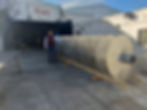
Screw Conveyor - Auger Flight- Screw Sectional Flight - Auger Conveyor - Sectional Flight - Auger Screw Conveyor - Screw Auger - Flight Sectional - Screw Feeder - Sectional Flight Auger - Hardfacing Screw Conveyor - Helix Flight - Sectional Flight Forming - Custom Helix Flight - Helical Flight - Helicoid Flight - Screw Conveyor Flight - Shafted Screw Conveyor - Mixer Powder Machine - Flighting - Screw Conveyor Parts - Auger Conveyor - Shaftless Screw -Conveyor Screw - Spiral Pipe - Spiral Tube - Conveyor Screw - Screw Conveyor Auger - Screw Flights - Auger Screw - Conveyor Screw - Screw Dosing - Shaftless Screw Conveyor - Screw Coveyor Auger - Screw Mixer Machine - Screw Conveyors - Auger Screw - Helicoid Flight - Ribbon Flight - Shaftless Flight - Conveyors Screw - Auger Flighting - Mixing Screw - Screw Conveyor Supplier - Screw Conveyor Manufacting - Screw Conveyor Manufacturer - Screw Conveyor Systems - Helicoid Screw Manufacturer - Centerless Screw - Screw Conveyor Manufacturers - Screw Flight Manufacturers - Heat Transfer Screw Processors -Screw Conveyor Heat Exchangers
Differences between a Screw Conveyor Shafted vs Screw Conveyor Shaftless
How to Select a Shaft or Shaftless Screw Conveyor

A question that many engineers and maintenance personnel ask about screw conveyors is "when should I use a shafted screw conveyor" or "when should I use a shaftless screw conveyor"? These are excellent questions and the answer should be researched for each individual operation as they assess their daily needs.
Why use a Shafted Screw Conveyor ?
A shaft screw conveyor is a piece of equipment that has a solid or tubular shaft that runs through the center of the screw flights. This helps to keep the screw above the trough or sleeve, avoiding friction that could lead to wear and metal detachment with contact and speed of rotation.
Shafted screw conveyor Advantages:
-
A shafted screw conveyor can be longer. In most applications, the shaft screw conveyor uses suspension bearings or bushings every 3 meters.
-
A shafted screw conveyor does not need a liner on the inside of the trough or tundish, resulting in less maintenance.
-
A shafted screw conveyor can run at higher rpm because there is no concern about wear on the bottom tundish liner.
Shafted helical screw conveyor Disadvantages:
-
Suspension bushings or bearings are required for longer conveyors. These can obstruct the flow of material on high capacity conveyors.
-
Shafted screw conveyors have a lower trough fill rate due to the need for suspension bearings. The typical fill rate for a shaft screw is around 15% -30%.
-
Shafted Screw Conveyor are not suitable for fibrous or pasty materials.
-
Shafted screw conveyors may have a higher capital cost in certain situations with flanged shafts and flexible suspension bearings.

Screw Conveyor Shaft

Filling Rate Screw Conveyor
Why Use Shaftless Screw Conveyors?
A shaftless screw conveyor has only one spiral or helix without a central shaft. The shaftless screw conveyor rotates on a liner that is usually made of engineering plastic. The only connection point on a shaftless screw conveyor is at the drive end of the screw conveyor.
Shaftless screw conveyor Advantages :
-
One of the main reasons for using a shaftless screw conveyor is the ability to handle different types of material. Shaftless screw conveyors can handle viscous, sticky, wet and lumpy materials.
-
Without the need for suspension bearings, a shaftless screw conveyor can have a higher fill rate, about 35% -40%. For applications such as live bottom hoppers and controlled feed, a 100% shaftless screw conveyor is possible.
-
Shaftless screw conveyors are ideal to feed vertical screw conveyors as there is no lower shaft or seal.
Shaftless screw conveyor Disadvantages:
-
A shaftless screw conveyor will need to remove the liner and replace it as it is a component that wears out over time due to contact or friction when the screw conveyor rotates. This can often be a problem if the screw conveyor is located high up or in an inaccessible location.
-
For very long lengths and higher volume bulk material handling applications, there will be a need for bracing on the screw conveyor, due to compression of the scroll under thrust load and elongation under tensile load.

Screw Auger Shaftless

Filling Rate Screw Conveyor Shaftless
Conclusion on Shafted screw conveyors vs Shaftless screw conveyors
Screw conveyors are widely used in industry. Both shafted and shaftless screw conveyor designs have their advantages and disadvantages, and the final choice generally comes down to the characteristics of the bulk material it will handle. Definitely a viscous, pasty and sticky product the solution is a shaftless screw conveyor, and meanwhile a solid material powders, grains, seeds are generally handled with a shaft screw conveyor, before making any decision, consult your advisor Bega, who will gladly assist you.
Recommended articles to learn more about a Screw Conveyor (Auger)

Advantages and Differences Between Conventional Grain Augers and Custom Screw Conveyors

Advantages Between a Shaftless Screw Conveyor and a Shaft Screw Conveyor

Know the characteristics of a ribbon mixer and its advantages












